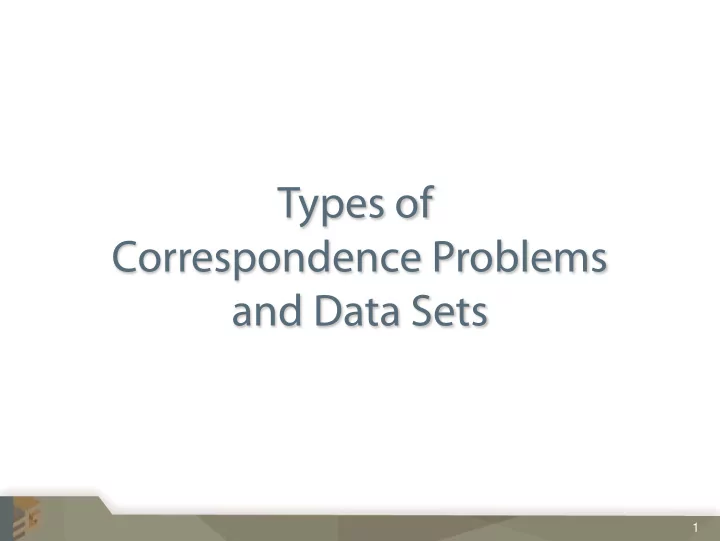

Types of Correspondence Problems and Data Sets 1 1
Correspondence ⇔ Registration 2
Correspondence Problem Classification How many meshes? • Two: Pairwise registration • More than two: multi-view registration Initial registration available? • Yes: Local optimization methods • No: Global methods Class of transformations? • Rotation and translation: Rigid-body • Non-rigid deformations 3
Correspondence Problem Classification Type of algorithm can depend on type of data that is available, or desired application • Data: typical 3D scans • Application: 3D model reconstruction 4
The Bunny 5
Error Accumulation and Multi-View Registration 6
Nonrigid Alignment 7
Nonrigid Alignment 8
Correspondence Problem Classification Type of algorithm can depend on type of data that is available, or desired application • Data: real-time 3D scans • Application: animation reconstruction 9
Structured Light Scanners color-coded motion compensated space-time structured light structured light stereo courtesy of Phil Fong, courtesy of Sören König, courtesy of James Davis, Stanford University TU Dresden UC Santa Cruz 10 1
Passive Multi-Camera Acquisition segmentation & photo-consistent belief propagation space carving [Zitnick et al. 2004] Christian Theobald Microsoft Research MPI-Informatik 11 1
Time-of-Flight / PMD Devices Minolta Laser Scanner (static) PMD Time-of-flight camera 12 1
Animation Reconstruction Problems • Noisy data • Incomplete data (acquisition holes) noise • No correspondences holes missing correspondences 13
Animation Reconstruction Remove noise, outliers Fill in holes (from all frames) Find dense, temporally coherent correspondences 14
Correspondence Problem Classification Type of algorithm can depend on type of data that is available, or desired application • Data: collection of models • Application: statistical shape model 15 15
Statistical Shape Spaces Courtesy of N. Hassler, MPI Informatik • Scan a large number of individuals • Different poses • Different people • Compute correspondences • Build shape statistics (PCA, non-linear embedding) 16
Statistical Shape Spaces Numerous Applications: • Fitting to ambiguous data (prior knowledge) • Constraint-based editing Courtesy of N. Hassler, MPI Informatik • Recognition, classification, regression Building such models requires correspondences Courtesy of N. Hassler, MPI Informatik 17
Correspondence Problem Classification Type of algorithm can depend on type of data that is available, or desired application • Data: single 3D model • Application: extract symmetries 18 18
Symmetries: Exact, Approximate, Partial 19
Scanner Data – Challenges “Real world data” is challenging, due to limitations in acquisition • More noise for large working volumes • Dynamic harder than static • Passive (e.g. stereo) less robust than active More than just “Gaussian noise”… 20
Challenges “Noise” • “Standard” noise types: • Gaussian noise (analog signal processing) • Quantization noise • More problematic: structured noise Courtesy of J. Davis, UCSC • Spatio-temporal correllations • Structured outliers • Reflective / transparent surfaces • Incomplete Acquisition • Missing parts • Topological noise Courtesy of P. Phong, Stanford University 21
Correspondence Problem Classification How many meshes? • Two: Pairwise registration • More than two: multi-view registration Initial registration available? • Yes: Local optimization methods • No: Global methods Class of transformations? • Rotation and translation: Rigid-body • Non-rigid deformations 22 22
Today We Will Explore... Pairwise, local registration • Rigid, non-rigid Animations • Many meshes, but (trivial) initial guess available Global registration • Rigid, non-rigid Symmetry • Special case: align mesh to transformation of itself • Rigid, non-rigid 23 23
Recommend
More recommend